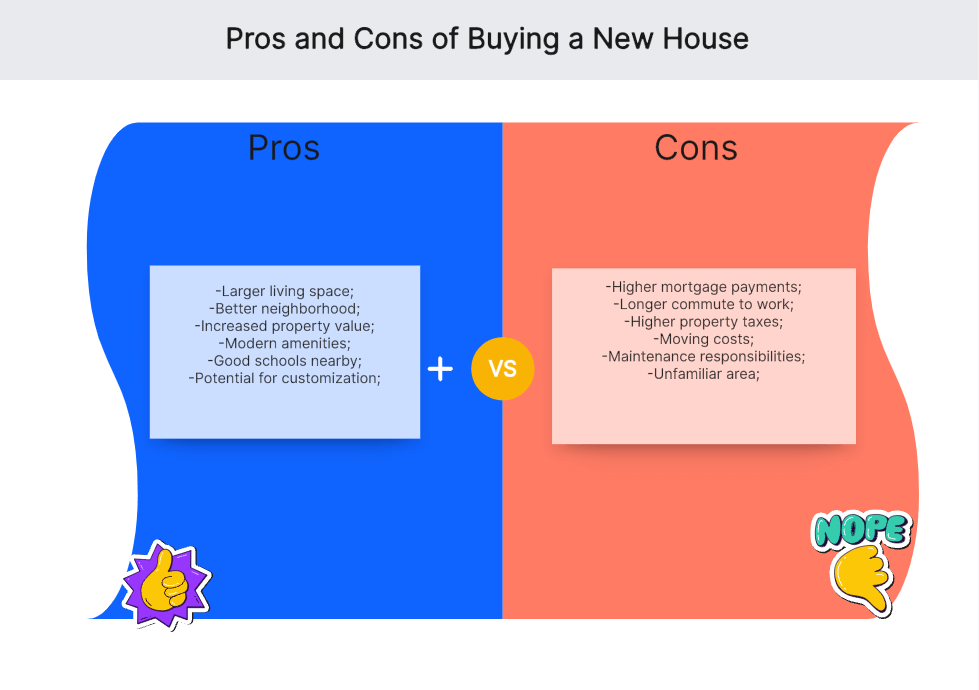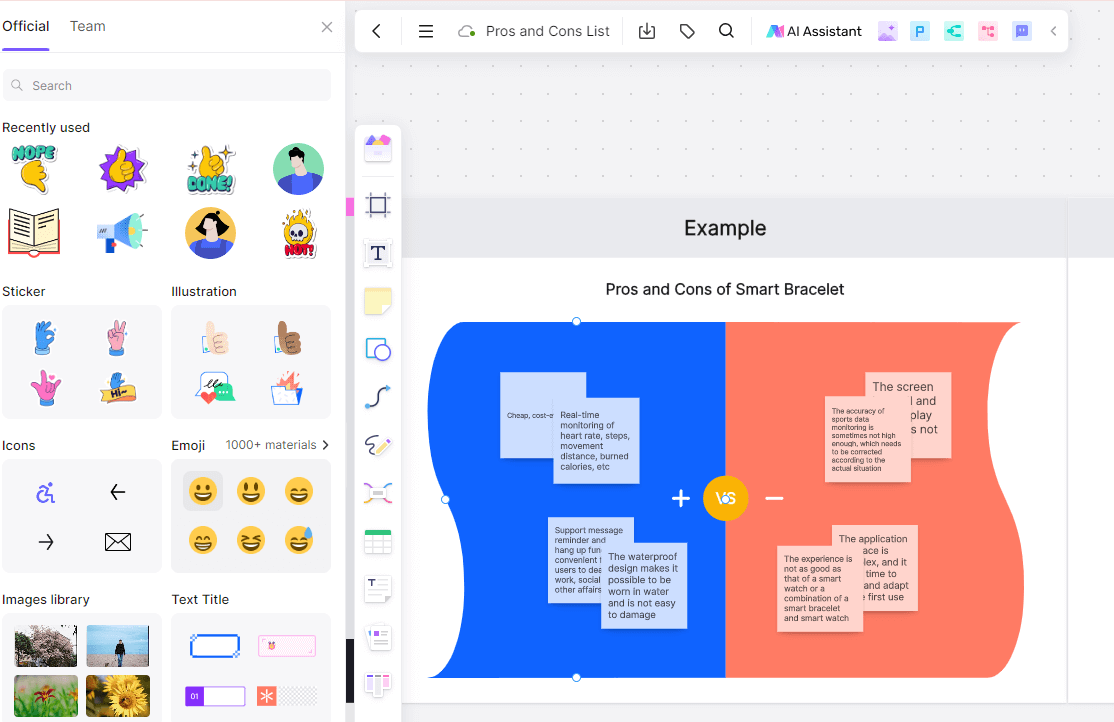Whether considering a significant life change or evaluating business opportunities, a Pro-Con list can be invaluable. Creating and utilizing Pro-Con lists has never been more efficient and effective with the advent of collaborative online tools. This article delves into the benefits of crafting Pro-Con lists, providing a detailed guide on how to leverage this tool to enhance your decision-making process.
What is a Pros and Cons List?

A Pros and Cons list is a visual tool used to outline the positive and negative attributes of a decision, situation, or choice. It is often employed to facilitate clearer thinking and more balanced judgment by visually organizing the different aspects of an option. This list is typically divided into two columns: one for the "Pros" (advantages or benefits) and one for the "Cons" (disadvantages or drawbacks).
Components of a Pros and Cons List
Title or Decision Point: The specific decision, option, or situation being evaluated.
Pros Column: A list of all the positive aspects, benefits, and advantages.
Cons Column: A list of all the negative aspects, drawbacks, and disadvantages.
Why Use a Pros and Cons List?
Using a Pros and Cons list is beneficial for several reasons, making it a valuable tool for decision-making. Here are some key reasons to use a Pros and Cons list:
1. Clarity in Decision-Making
A Pros and Cons list helps to clearly outline the positive and negative aspects of a decision, making it easier to understand the implications. This clarity can simplify complex decisions by breaking them down into manageable components.
2. Balanced Perspective
By listing both advantages and disadvantages, a Pros and Cons list encourages a balanced view. This helps in avoiding bias and ensures that all factors are considered before making a decision.
3. Visual Organization
Seeing the pros and cons laid out in a visual format can make it easier to compare and contrast different aspects of a decision. This visual organization aids in better understanding and analysis.
4. Enhanced Objectivity
A Pros and Cons list promotes objectivity by focusing on tangible benefits and drawbacks. This helps to minimize emotional influence and enables more rational decision-making.
5. Aids in Prioritization
Not all pros and cons are of equal importance. A Pros and Cons list allows you to prioritize different factors based on their significance, helping to focus on what matters most.
6. Reduces Regret
By thoroughly evaluating all aspects of a decision, a Pros and Cons list can help reduce the likelihood of regret. Knowing that all factors were considered can provide peace of mind that the best possible decision was made.
Pros and Cons List Examples
Here are some examples of Pros and Cons lists for different scenarios to illustrate how this tool can be used effectively in various decision-making contexts:
1. Pros and Cons of Buying a New House

2. Pros and Cons of Starting a Remote Job

3. Pros and Cons of Getting a Master's Degree

4. Pros and Cons of Switching to a Plant-Based Diet

These examples show how Pros and Cons lists can be tailored to a variety of personal and professional decisions, providing a clear framework to help evaluate the benefits and drawbacks of each option.
How to Effectively Create a Pro-Con List?
Creating an effective Pros and Cons list involves a systematic approach to ensure that all relevant factors are considered and evaluated. Here are the steps to effectively create a Pros and Cons list:
Step-by-Step Guide:
1. Define the Decision or Issue
Clearly articulate the decision, choice, or issue you are evaluating. This helps to focus the list and ensure that it addresses the specific topic.
2. Set Up the List
Create a two-column table, labeling one column as "Pros" and the other as "Cons."
3. Brainstorm the Pros and Cons
List all the positive aspects, benefits, and advantages of the decision. Consider all potential impacts, including short-term and long-term benefits. List all the negative aspects, drawbacks, and disadvantages of the decision. Think about immediate and future challenges or negative outcomes.
4. Evaluate Each Factor
Consider the significance of each pro and con. Some factors may carry more weight than others. You can add notes or use a scoring system to indicate the importance of each item.
5. Seek Additional Input
If applicable, gather input from others who may be affected by the decision or who can offer valuable perspectives. This can help ensure that the list is comprehensive and balanced.
6. Seek Additional Input
If applicable, gather input from others who may be affected by the decision or who can offer valuable perspectives. This can help ensure that the list is comprehensive and balanced.
Tips for Effectiveness:
Be Honest and Objective: List all factors truthfully, without bias. Include all relevant pros and cons, even if they seem minor.
Prioritize Factors: Not all factors have equal importance. Highlight or score the most critical ones to emphasize their impact.
Consider Long-Term Effects: Think beyond immediate benefits or drawbacks. Consider the long-term implications of each factor.
Keep It Simple: While thoroughness is important, keep the list clear and concise to avoid overwhelming yourself with too much information.
Update as Needed: If new information or perspectives emerge, update the list accordingly. Decision-making is often an ongoing process.
Creating an effective Pros and Cons list requires clear definition, thorough brainstorming, and thoughtful evaluation. By following these steps and tips, you can ensure that your list provides valuable insights and helps you make a well-informed decision.
Why Create a Pro-Con List Template in Boardmix?
Creating a Pro-Con list template in Boardmix can be highly beneficial for several reasons, especially considering its features and functionalities. Here's why using Boardmix for this purpose is advantageous:
1. Visual Organization
Boardmix offers a range of tools to create visually appealing and organized templates. A well-structured Pro-Con list in Boardmix can include features like color coding, different fonts, and layout options, making it easier to read and analyze.
2. Interactive Features
Boardmix includes interactive elements like drag-and-drop functionality, which makes it easy to rearrange pros and cons as priorities change. You can also add comments and notes to each point for further clarification and discussion.
3. Templates and Customization
Boardmix provides various templates that can be customized to suit specific needs. You can create a standard Pro-Con list template and adjust it for different decisions, ensuring consistency and saving time.

4. Version Control
Boardmix keeps track of changes made to documents, allowing you to review the history of your Pro-Con lists. This is useful for understanding how decisions evolved and ensuring transparency in the decision-making process.
How to Create a Pro-Con List Template in Boardmix?
Step 1: Set Up the Template
Open Boardmix create a new document, and title the document appropriately, such as "Pro-Con List Template."
Step 2: Create the Layout
Divide the document into two columns: one for "Pros" and one for "Cons." Use Boardmix’s grid or table features to ensure a neat and organized structure.
Step 3: Add Interactive Elements
Include text boxes or sticky notes for each pro and con. Use different colors to differentiate between high-priority and low-priority items.
Step 4: Customize for Specific Use Cases
Add sections or headers for different categories if needed (e.g., financial, personal, professional). Incorporate space for additional notes or comments for each item.
Step 5: Save and Share the Template
Save the template for future use, and share the document with team members or collaborators, setting appropriate access permissions.
Using Boardmix to create a Pro-Con list template leverages the tool’s collaborative, interactive, and customizable features. This not only enhances the efficiency and clarity of the decision-making process but also ensures that all relevant factors are thoroughly considered and documented.
By harnessing the power of Boardmix for your Pro-Con lists, you unlock a new level of clarity and collaboration in your decision-making process. The ease of real-time input, visual organization, and seamless integration with other productivity tools make Boardmix an essential resource for anyone looking to make balanced, well-informed choices. Embrace the future of decision-making with Boardmix, and turn your complex decisions into clear, actionable insights.








